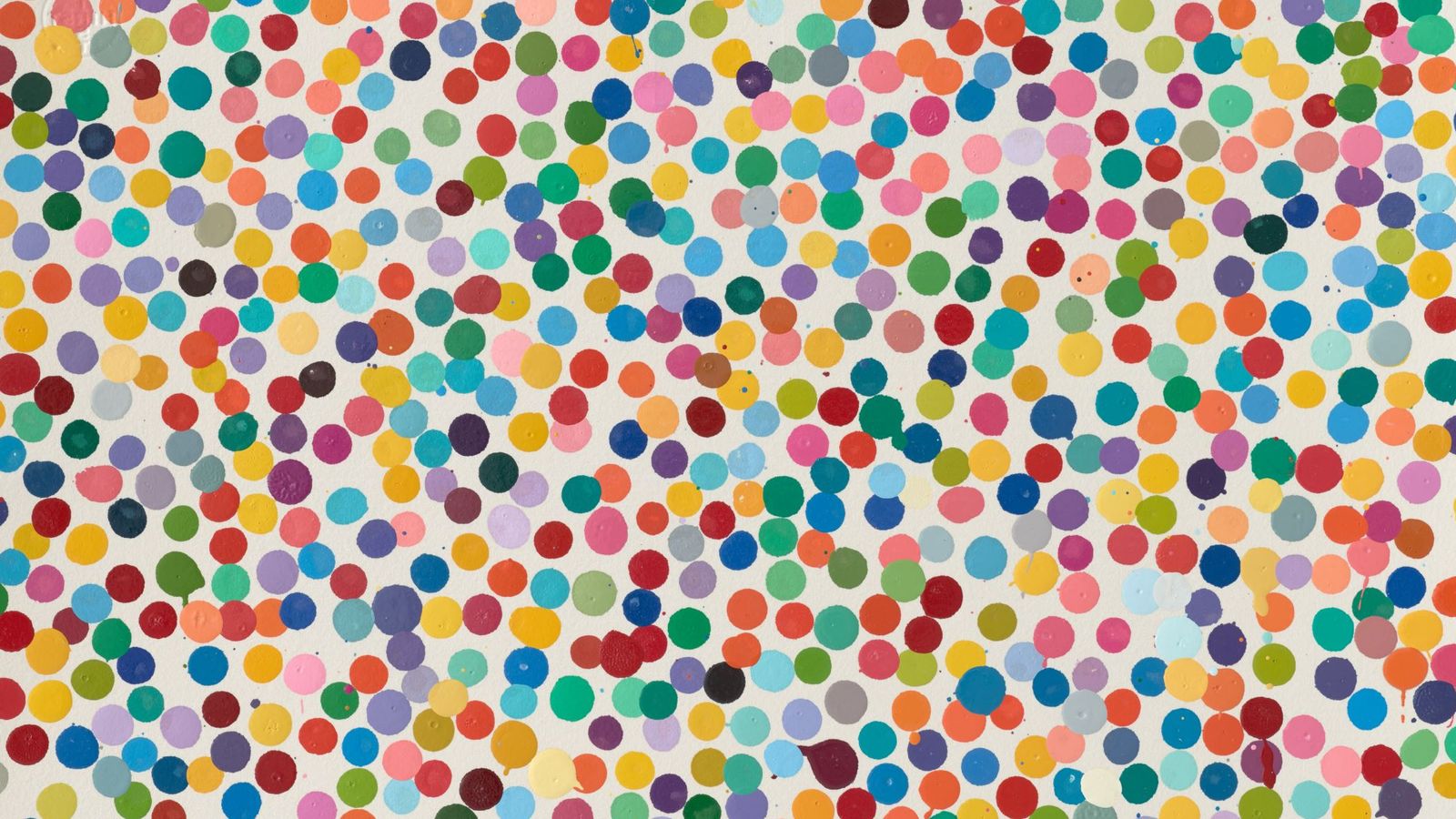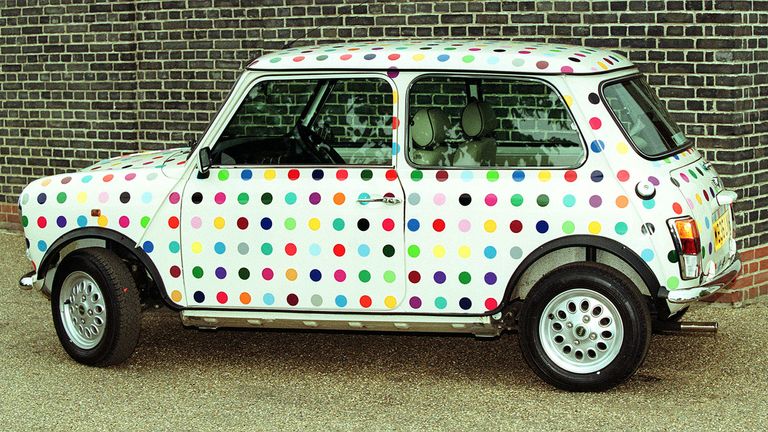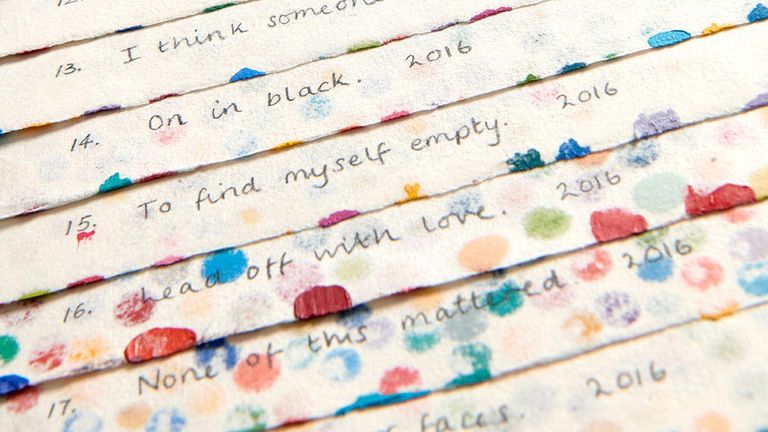When he’s not preserving dead animals in formaldehyde or encrusting skulls with diamonds, Damien Hirst is known for his spots.
On the surface, they appear to be a more innocent affair, clusters of rainbow blobs that simply make the beholder feel happy, rather than provoking the outrage that a pickled shark or sliced-down-the middle cow and her calf might, say, or a photograph of the artist posing and grinning next to a severed human head.
That was until Hirst announced his spots were to become part of an NFT experiment, The Currency, a project met with glee and admiration by some in the art world and fans of his work – but a fair amount of scepticism and criticism, too.
First up, for those who managed to avoid the explosion in the past couple of years, an NFT is a non-fungible token, a unique digital asset. NFTs can be anything digital – music, video clips, art, even a tweet.
In 2021, Collins Dictionary made NFT its word of the year, and an NFT created by digital artist Beeple sold for $69.3m (£50.3m at the time) through Christie’s – the first sale ever by a major auction house of a piece of art that does not exist in physical form.
For a short period of time, NFTs seemed a sure-fire way for artists and investors to make money. Following the initial boom, the market has crashed somewhat, but does that matter for those who simply want to enjoy their digital art? It’s a concept many find difficult to get their heads round.
Enter the industry’s enfant terrible Hirst, who in 2016 began work on a conceptual art project, creating 10,000 unique but visually similar A4-sized spot paintings. In July 2021, he revealed these would form the basis of The Currency, his first NFT collection.
Would-be buyers entered a lottery to pick up a piece for $2,000 (about £1,770 now, something of a bargain for a Hirst original). Those who were successful were given a choice: keep the NFT and see the physical painting incinerated, or swap it for the original, obliterating the digital version.
They had a year to make their minds up and the split was tighter even than that other famous controversial vote that started in 2016: 5,149 buyers opted for the physical artworks, 4,851 kept the NFTs.
It should be noted here that this figure is slightly skewed, however, by the fact Hirst backed the new art form he was embracing, keeping 1,000 pieces as NFTs for himself. But still, there is plenty of confidence in digital among fans of the project, too.
Some made their minds up quickly, others waited until the end. In September 2021, the buyer of number 2,604, titled Revocation, sold it on for $172,239 (about £150,000 now). This was the NFT version. According to Hirst’s book on the project, The Currency has so far generated $89 million (£78.9m) in sales.
Boundary-pushing or a publicity stunt?
The experiment is now on display to the public at Hirst’s Newport Street Gallery in Vauxhall, south London. Ten thousand artworks sounds like a lot, but it’s perhaps only when you see the display in real life that you can appreciate the project’s scale. (Sorry, NFT aficionados, the digital realm just doesn’t quite capture the size in the same way.)
Each artwork is numbered, titled, stamped, and signed by Hirst, with a watermark, a microdot and a hologram containing his portrait, and a title generated through AI using some of his favourite song lyrics. On each piece, no colour is repeated.
All 10,000 paintings are represented at the gallery, suspended in perspex. The 5,149 works whose owners opted for the physical are greyed out, the pieces now no doubt cheering up walls around the world; the remaining 4,851 are tangibly there, ready for their multimillion-pound bonfire, due to begin in October. The painting pyres await them upstairs.
Hirst says he views The Currency as a work of art in which people participate by buying, holding, selling and exchanging the pieces.
So, is his testing of the worth of digital art versus physical a genius, boundary-pushing endeavour – or just another publicity and money-making stunt?
Writing for the i paper, art critic Florence Hallett describes The Currency as “rather like a small child dangling teddy over the lavatory in a bid for the upper hand – only with considerably less sincerity and stupendous amounts of money”.
In a column entitled “How it all went wrong for Damien Hirst”, The Sunday Times’ chief art critic Waldemar Januszczak – who says he was a loyal admirer of the artist’s previous work – describes NFTs as something “invented by the Devil to lure fools into the art world and persuade them to spend their money on nothing”.
But for one of the art world’s greatest provocateurs, the criticism surely only adds to the enjoyment. And he has more than enough admirers of his work.
‘I don’t think appreciating art in person is better or worse’
Molly Jane Zuckerman, who is head of content for the crypto data provider CoinMarketCap, entered the ballot to pick up a piece of The Currency, but was unsuccessful. Despite her work in the crypto industry, she says she would have chosen the physical painting as an NFT version would have felt like a “pale imitation” of an original Hirst.
However, she believes it is all down to personal preference.
“Some NFT digital art is so cool. I own a few NFTs that I think are fascinating. Most of them cost me less than $3 and I just like looking at them…
“But I like to appreciate my art in person. And I don’t think that appreciating art in person is necessarily better or worse or makes art more valid, if you can touch it, it was painted, versus being created online. I just think every person has different ways that aesthetics please them.
“I would love a Damien Hirst hanging in my house and I would feel less aesthetically pleased by seeing it on my iPhone or as my profile picture. But people like different things and I can’t fault them for wanting to have, you know, a $2 million picture of a monkey on their profile picture. That’s completely their prerogative.”
‘I don’t know if it’s right or wrong, but it’s been a rollercoaster’
Artist Roy Tyson, who goes by the name Roy’s People, is known for his work with miniature figurines, and often uses other creators’ themes – including Banksy, Keith Haring and Hirst – as backdrops for his own.
In 2021, he became the owner of The Currency piece 4,967, titled What Am I To Know, and earlier this year made the decision to keep the physical painting and destroy the NFT.
“I’m a big fan of Hirst and I love the way he pushes the boundaries and doesn’t answer to anyone, doesn’t really sort of stick to any old-fashioned rules of the art world,” Tyson says. “My original thinking when this came out was, ‘wow, an original Damien Hirst for £1,500’. That’s unheard of, no brainer.”
But seeing some NFT versions sell for high sums early on made him temporarily re-evaluate.
“You start thinking, what could this be worth? It’s been such a journey… in the end I decided to go with my original thinking. I don’t know if that’s the right or wrong thing, but it’s been quite a rollercoaster.”
Tyson has only created physical artworks himself but says the same rules apply when it comes to purchasing digital art.
“With collecting art with a view to investment rather than collecting art for art’s sake, you’ve got to know what you’re buying.
“It kind of feels like it probably is the art of the future and the way people might collect. Look at cash, you know, cash has disappeared. Digital currency, essentially, we just see numbers on our on our screens. But I don’t think physical art will ever disappear.”
Which will be worth more?
Of course, destroying art is nothing new. In the case of Banksy’s Love Is In The Bin – the artwork that shredded itself after being sold in 2018 – it only added to its value, selling again for £18.5m in October 2021, a record for the artist at auction.
Hirst himself claims he struggled with the decision of what to do with his own 1,000 pieces from the collection, saying he was “all over the f****** shop with my decision making, trying to work out what I should do”.
Writing on Twitter in July, he said: “I believe in art and art in all its forms but in the end I thought f*** it! this zone is so f****** exciting and the one I know least about and I love this NFT community it blows my mind.”
While she doesn’t necessarily consider NFTs completely the future of art, Zuckerman believes Hirst’s project is an interesting exploration of what consumers deem valuable.
“Artists do experiment,” she says. “I think that a lot of what [Hirst] does with dots and with his [physical] artwork, you know, 100, 200 years ago also wouldn’t be considered art. And now it is, once people moved on beyond just considering realism, oil paintings, you know, biblical paintings, art.
“I am all for artists experimenting with as many forms as possible. I think there are really cool things that NFTs can do and can bring. NFTs can change over time, they can evolve. They can be 3D rotating figures, something that a pencil, a paintbrush physically cannot do. So I don’t think there’s any reason for artists not to use NFTs.”
Read more:
Muse claim first UK number one album with NFT tech
Why are some digital artworks selling for milllions?
However, she adds that NFTs are no longer a certain fast-track to making money.
“If you are buying an NFT for a specific reason – you want to be part of an exclusive club, for example. The Bored Ape Yacht Club, people that own those NFTs, they do get the perks of being in this community; there are events, there are meet-ups, there’s the clout associated with it on social media and sometimes in real life as well. That makes sense to own an NFT.
“If you want to support an artist, definitely, buying their art in any form is supporting that particular artist. If you want to make a quick buck, that’s not really the case anymore. The hype in terms of flipping NFTs for making a significant amount of money, it definitely still can be done but it’s not the [case of] taking candy from a baby that it was about a year ago.”
Six months, five years, a century down the line: which of The Currency works will be worth more?
Hirst says he is “proud to have created something alive, something and provocative” – and that the excitement is in the unknown.
“I have no idea what the future holds, whether the NFTs or physicals are going to be more valuable or less. But that is art! The fun, part of the journey and maybe the point of the whole project. Even after one year, I feel the journey is just beginning.”
The Currency exhibition is open now at Newport Street Gallery, running until 30 October 2022






